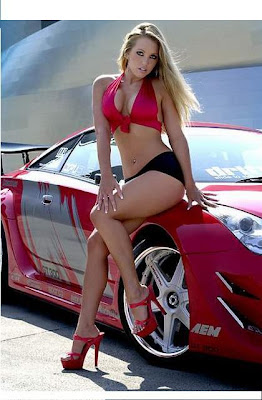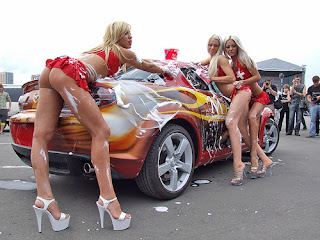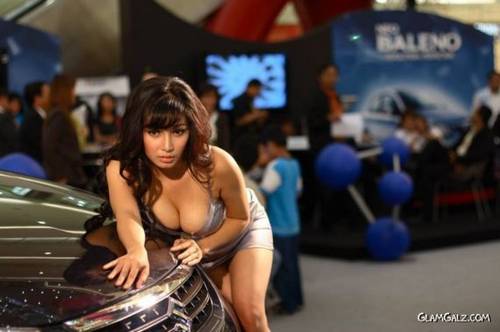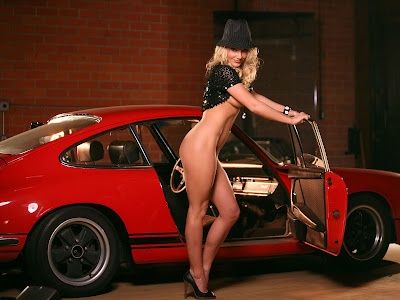|
|---|
Wednesday, November 3, 2010
Porsche has since its inception by Ferdinand Porsche been a maker of high performance sports cars. Most notably the iconic 911 model which has continually evolved throughout the years to become a benchmark against which many other sports cars are measured. The 911 in all its iterations has been Porsche's bread and butter, along with the Boxster and Cayman in more recent years. Every decade or so however, Porsche brings something special out of it's factories. A supercar!
Porsche's first two supercars were produced to satisfy FIA homologation standards. This required that 200 road legal cars had to be made and sold to the public in order for the car to qualify for racing in FIA sanctioned races. The first car was the 959 which was introduced in 1986. Looking like a heavily modified 964, the 959 however was so much more. It sported a 2.8L twin-sequential-turbocharged flat-six engine that put out 444 HP. This was put to the ground with an innovative 4-wheel drive system. A first for Porsche, which worked so well, a similar system was later adapted for use on the 993 turbo, and has been a staple of Porsche's 911 turbo models ever since. In its day, the 959 was actually the fastest production car in the world, with a top speed of 200 mph and a 0-62 time of 3.7 sec. Impressive even today. The 959 continued in production through 1989.
The second Porsche supercar was the 911 GT1, which was based on a heavily modified 993 platform. Like the 959, it was produced and made available to the public for homologation purposes so that it could be raced by Porsche at Le Mans. The 911 GT1 was produced from 1996-1999. It has a water cooled twin-turbo flat-six engine that produced 700 bhp. With a 2400lb curb weight, the 911 GT1 was extremely fast. It had a 0-62 time of 3.3 seconds and a top speed of 235 mph.
In 1999, Porsche was looking to produce a new Le Mans racecar. It was originally slated to have a flat-six engine as their previous racers had. Later though, a 5.5L V10 engine was designed, however this delayed the project until 2000. The engine was then increased in displacement to 5.7L. Shortly afterward, the Le Mans project was canceled. At the same time, some of the Porsche management had been wanting to produce a new supercar for the public. Something that would bring Porsche a great deal of attention from the world. A new supercar was green lighted by management, with no restrictions that it share parts with any of their regular production cars. This freedom to build whatever they wanted opened the design team up to build a clean sheet car. Since the Le Mans project had been canceled, the newly designed V10 engine was waiting to be used in some way. It turned out to be just what the design team was looking for. With some tweaking to make it more driver friendly, Porsche now had a 5.7 Liter V10 that output 612 HP at 8400 rpm. This engine needed a car to propel still. A new carbon fiber composite chassis was designed, which was coupled with aluminum subframes. Carbon composite body panels were also crafted.
Instead of using an automated manual transmission with paddle shifting as was becoming popular in the supercar world, a six speed manual was decided upon to provide a more involved driving experience. However, it was desired by the design team to keep the engine mounted as low as possible in the middle of the car to lower the center of gravity, and thus better the handling of the car. To do so, the engineers designed the smallest clutch that's been used in production car, a 6 inch diameter twin plate carbon fiber clutch. The small size of the clutch gave it very low inertia, which let the engine rev very quickly. Some have said the clutch is tricky to get a hang of when first driving the car. It has been said however that the way to drive it is to first let the clutch out, then once rolling apply the throttle. Stalling should be a non-issue then. The Carrera GT for a while held the record time for a production car on the Nurburgring of 7:28, set by Porsche driver Walter Rorhl. The Carrera GT had a 0-62 speed of 3.9 seconds, and a top speed of 205 mph. It sold for a base sticker price of $440,000.
Porsche's first two supercars were produced to satisfy FIA homologation standards. This required that 200 road legal cars had to be made and sold to the public in order for the car to qualify for racing in FIA sanctioned races. The first car was the 959 which was introduced in 1986. Looking like a heavily modified 964, the 959 however was so much more. It sported a 2.8L twin-sequential-turbocharged flat-six engine that put out 444 HP. This was put to the ground with an innovative 4-wheel drive system. A first for Porsche, which worked so well, a similar system was later adapted for use on the 993 turbo, and has been a staple of Porsche's 911 turbo models ever since. In its day, the 959 was actually the fastest production car in the world, with a top speed of 200 mph and a 0-62 time of 3.7 sec. Impressive even today. The 959 continued in production through 1989.
The second Porsche supercar was the 911 GT1, which was based on a heavily modified 993 platform. Like the 959, it was produced and made available to the public for homologation purposes so that it could be raced by Porsche at Le Mans. The 911 GT1 was produced from 1996-1999. It has a water cooled twin-turbo flat-six engine that produced 700 bhp. With a 2400lb curb weight, the 911 GT1 was extremely fast. It had a 0-62 time of 3.3 seconds and a top speed of 235 mph.
In 1999, Porsche was looking to produce a new Le Mans racecar. It was originally slated to have a flat-six engine as their previous racers had. Later though, a 5.5L V10 engine was designed, however this delayed the project until 2000. The engine was then increased in displacement to 5.7L. Shortly afterward, the Le Mans project was canceled. At the same time, some of the Porsche management had been wanting to produce a new supercar for the public. Something that would bring Porsche a great deal of attention from the world. A new supercar was green lighted by management, with no restrictions that it share parts with any of their regular production cars. This freedom to build whatever they wanted opened the design team up to build a clean sheet car. Since the Le Mans project had been canceled, the newly designed V10 engine was waiting to be used in some way. It turned out to be just what the design team was looking for. With some tweaking to make it more driver friendly, Porsche now had a 5.7 Liter V10 that output 612 HP at 8400 rpm. This engine needed a car to propel still. A new carbon fiber composite chassis was designed, which was coupled with aluminum subframes. Carbon composite body panels were also crafted.
Instead of using an automated manual transmission with paddle shifting as was becoming popular in the supercar world, a six speed manual was decided upon to provide a more involved driving experience. However, it was desired by the design team to keep the engine mounted as low as possible in the middle of the car to lower the center of gravity, and thus better the handling of the car. To do so, the engineers designed the smallest clutch that's been used in production car, a 6 inch diameter twin plate carbon fiber clutch. The small size of the clutch gave it very low inertia, which let the engine rev very quickly. Some have said the clutch is tricky to get a hang of when first driving the car. It has been said however that the way to drive it is to first let the clutch out, then once rolling apply the throttle. Stalling should be a non-issue then. The Carrera GT for a while held the record time for a production car on the Nurburgring of 7:28, set by Porsche driver Walter Rorhl. The Carrera GT had a 0-62 speed of 3.9 seconds, and a top speed of 205 mph. It sold for a base sticker price of $440,000.
Labels: New Sport Porsche Carrera GT

























